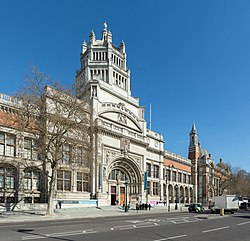Victoria and Albert Museum
 The Victoria and Albert Museum (2014) |
|
| Data | |
|---|---|
| place | London |
| Art |
Applied arts and design
|
| opening | 1852 |
| Number of visitors (annually) | 3.2 million (2013) |
| management | |
| Website | |
The Victoria and Albert Museum (often abbreviated V & A ) in 1852 under the name South Kensington Museum founded, is located on Cromwell Road in Kensington , West London and is home to the largest collection of Decorative Arts and Design in the world.
history
The museum began as a collection of plaster casts , engravings, and a few exhibits from the 1851 World's Fair . Together with the art patron Henry Cole, Prince Albert , Queen Victoria's consort , then created a concept for a museum that was to show the “application of art in handicrafts” - as a model for the British population. Cole, the first director, envisioned a museum of design and arts and crafts in a commercial context, not arts and crafts for the sake of arts and crafts. This philosophy is still represented today. The humble museum with the lofty ideas was first housed in a few wooden huts, then in the so-called Brompton boilers. It got bigger quickly. Study objects for the students were collected and donations arrived: British paintings by John Sheepshanks , the Bandinel collection with porcelain and ceramics, and the Gherardini collection with models and sculptures. Several rooms were added piece by piece, so that the central square courtyard and east courtyards were created; Aston Webb's galleries were front added from 1899 to 1909. Nevertheless, entire departments later had to move out to open branches of the Victoria & Albert Museum or independent museums elsewhere: the Science Museum , the Bethnal Green Museum of Childhood and the Theater Museum .
In the 20th century, the museum expanded into the adjacent Henry Cole Wing. Initially, a sensational new grand piano, The Spiral , based on a design by Daniel Libeskind was planned . The new building was discussed controversially in public, as many people believed that it did not fit in well with the historical building complex. The immense construction costs of 70 million pounds, most of which were to be financed with funds from the state lottery, also caused a lack of understanding. Nevertheless, in 2001, preparations for construction began. In 2004 it emerged that the Heritage Lottery Fund was planning to use the expected money for other purposes. Since the museum management saw no way of raising the construction costs on their own, it was finally decided to abandon the project.
In 2011, the architecture firm AL A received the order from Amanda Levete to plan a new entrance area of the museum. The new building will be completed in 2017 and will be named after the sponsor Leonard Blavatnik .
In September 2018, the V&A Dundee , a branch based on a design by the Japanese architect Kengo Kuma , opened in Dundee, Scotland .
The museum was visited by 3.2 million people in 2013. From September 1, 2011 to autumn 2016, it was directed by the German cultural historian Martin Roth . The British politician and Labor MP, PhD historian and journalist Tristram Hunt , who took office on February 20, 2017, was appointed as his successor.
In the course of the COVID-19 pandemic , the V&A Museum was closed for around five months until it reopened in August 2020.
Collections
The exhibits range from early Christian devotional objects to Doc Martens boots and paintings by John Constable to mystical art from Southeast Asia. The V&A Museum also houses sculptures, watercolors, jewelry and musical instruments that are well worth seeing. The V&A also houses the national sculpture collection with Gian Lorenzo Bernini's Neptune and Triton Fountain and Antonio Canova's Three Graces . The museum also houses part of the oldest surviving carpet in the world. It is the larger and well-preserved Persian carpet from the Ardabil carpet pair . The curiosities include the large bed from Ware and Tipus Tiger .
Casting yards
One of the most impressive parts of the museum are the casting yards, which consist of two large two-story rooms. They house hundreds of plaster casts of sculptures , friezes and tombs . One room is dominated by a full-size replica of the Trajan Column , which is shown in two parts. The other shows replicas of various works of the Italian Renaissance , including the David of Michelangelo . Earlier interpretations of the biblical figure David by Donatello and Verrocchio are also on display.
Affiliated collections
The museum also manages the Museum of Childhood in Bethnal Green . Earlier it was also Apsley House by the museum.
The own Theater Museum in Covent Garden was dissolved; the theater collection has since been exhibited in the main building.
Environment and transport links
Near the museum are the Natural History Museum and the Science Museum . The closest London Underground station is South Kensington , which is directly connected to the basement of the museum by a pedestrian tunnel.
gallery
Web links
- The museum website (English)
- Website with images of the spiral
- BBC story on axing of Spiral extension
Individual evidence
- ^ Enough for the grand piano in FAZ of April 25, 2016, page 15.
- ↑ Visitor statistics on alva.org.uk , accessed on July 29, 2014.
- ↑ monopol magazine for art and life from January 13, 2017: successor to Martin Roth. London's V&A Museum appoints new director , accessed January 14, 2017.
- ↑ Fine art and face masks: London's Victoria and Albert Museum reopens. In: Reuters. August 5, 2020, accessed on August 5, 2020 .














